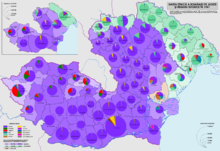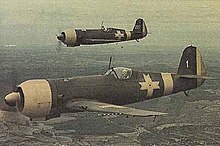
Southern Transylvania
Southern Transylvania was a region of the Kingdom of Romania between 1940 and 1944, during World War II. The region of Transylvania, belonging entirely to Romania when the war started in 1939, was split in 1940 between Romania and Hungary, with the latter taking Northern Transylvania in the aftermath of the Second Vienna Award.

Overview
Timișoara was the largest city in Southern Transylvania, with a population of 116,878 as of April 1941. However, this city was located in the Banat sub-region. The largest city in Southern Transylvania-proper was Brașov, with a population of 84,557 as of April 1941. Southern Transylvania-proper had a population of just over 1.74 million people.[1]

Southern Transylvania (including its adjacent regions to its West) had a total area of 59,000 square kilometers.[2] Subtracting from this area the areas of the five counties to its West: Timiș-Torontal (7,600 square km), Caraș (4,693), Severin (6,422 square km), Arad (6,248 square km) and the half of Bihor (~3,700 square km) which remained in Romania after the Second Vienna Award, the area of Southern Transylvania-proper amounted to just over 30,000 square km.

-
German map of Southern Transylvania, showing the ethnic German population
-
Romanian counties as of 1942: Southern Transylvania had a total of 13, 8 belonging to Southern Transylvania-proper
-
This map depicts the Jewish population in Romania by county, but it also shows how the Vienna Award split Bihor County (dark blue, West)
Armaments industry




The following is a list of weapons produced during World War II and the years prior throughout the Romanian (Southern) part of Transylvania-proper.

Weapons
| Vessel | Design/Licence Origin | Number | Notes | ||
|---|---|---|---|---|---|
| Submachine guns | |||||
| Orița M1941 | 6000+ | Local design, entered operational service with the Romanian Army in 1943 with a production rate of 666 pieces per month as of October 1942[3] (6,000 produced until October 1943)[4] | |||
| Machine guns | |||||
| ZB vz. 30 | 10,000 | 10,000 licence-built locally at Cugir after Czechoslovak design,[5] with a production rate of 250 pieces per month as of October 1942[6] | |||
| Mortars | |||||
| Brandt Mle 27/31 | 410+ | Licence acquired from France to produce 410 mortars at the Voina Works in Brașov, but the number specified by the licence was far exceeded during the war, with a production rate of 30 pieces per month as of October 1942[7][8] | |||
| Anti-aircraft guns | |||||
| 3.7 cm flak | 360 | 360 produced under German licence at the Astra Works beginning with 1938, with 102 delivered by May 1941 and a production rate of 6 pieces per month as of October 1942[9] | |||
| 75 mm Vickers | 200 | 100 built under British licence acquired by the Reșița Works beginning with 1936, with 100 delivered by mid-1941 and then a second batch of 100 started in July 1941 outside the licence, the production rate being of 5 pieces per month as of October 1942; it appears that, although the licence was acquired by Reșița, the actual production took place at Astra[10] | |||
| Anti-tank guns | |||||
| 75 mm Reșița | 120 | Native design combining features from several foreign models, a total of 120 pieces were produced at the Astra Works in Brașov[11] | |||
Transylvanian monthly armament production (October 1942)[12]

| Model | Production capacity | Actual production | Percentage of production capacity achieved |
|---|---|---|---|
| Orița M1941 submachine gun | 1,080 | 666 | 62.35% |
| ZB vz. 30 machine gun | 500 | 250 | 50% |
| Brandt 81 mm mortar | 90 | 30 | 33.33% |
| Rheinmetall 37 mm AA gun | 16 | 6 | 37.5% |
| Vickers 75 mm AA gun | 8 | 5 | 62.50% |
Aircraft (armed)
- IAR 80 (448 built)[13]
- IAR 37 (220 built)[14]
- IAR 79/SM.79 (67 built)[15]
- Potez 25 (184 built)[16]
- Messerschmitt Bf 109 (17 built)[17]
- PZL P.11 (95 built)[18]
- PZL P.24 (25 built)[19]
Ammunition
There were factories for the assembly and filling of artillery shells at Orăștie, Avrig and Copșa Mică. The one at Avrig was the largest, accounting for up to 40% of the total Romanian production of artillery shells.[20] In 1942, the Nitramonia plant in Făgăraș started producing explosives.[21]

Armored fighting vehicle components
Two Transylvanian factories, Industria Sârmei in Turda and IAR in Brașov, along with one factory outside Transylvania (Concordia in Ploiești), were responsible for the production of the torsion bars and wheels used in the manufacturing of the TACAM T-60 tank destroyers. The Astra Works in Brașov, together with the Lemaitre Works in Bucharest, were responsible for the finishing of the gun carriages used by the TACAM T-60 tank destroyers (the carriages were designed and cast at Concordia).[22] For Romania's Renault R35 tanks, IAR in Brașov finished the cylinder heads and drive shafts which were cast at the Basarab Works in Bucharest.[23]

Artillery components
The Astra Works produced gun barrels for Romania's Skoda 150 mm and 100 mm howitzers.[24]

References
- ^ Sabin Manuilă, 1941, Data of the general census from 6 April 1941 (in Romanian)
- ^ Stefano Bottoni, Lexington Books, 2018, Stalin's Legacy in Romania: The Hungarian Autonomous Region, 1952–1960, p. 18
- ^ Mark Axworthy, London: Arms and Armour, 1995, Third Axis, Fourth Ally: Romanian Armed Forces in the European War, 1941–1945, p. 75
- ^ Mark Axworthy, London: Arms and Armour, 1995, Third Axis, Fourth Ally: Romanian Armed Forces in the European War, 1941–1945, p. 149
- ^ John Walter, Greenhill Books, 2004, Guns of the Third Reich, p. 86
- ^ Mark Axworthy, London: Arms and Armour, 1995, Third Axis, Fourth Ally: Romanian Armed Forces in the European War, 1941–1945, p. 75
- ^ Mark Axworthy, London: Arms and Armour, 1995, Third Axis, Fourth Ally: Romanian Armed Forces in the European War, 1941–1945, pp. 29-30 and 75
- ^ Great Britain. Foreign Office, Ministry of Economic Warfare, 1944, Rumania Basic Handbook, p. 27
- ^ Mark Axworthy, London: Arms and Armour, 1995, Third Axis, Fourth Ally: Romanian Armed Forces in the European War, 1941–1945, pp. 30 and 75
- ^ Mark Axworthy, London: Arms and Armour, 1995, Third Axis, Fourth Ally: Romanian Armed Forces in the European War, 1941–1945, pp. 30 and 75 and page 5 of the photo album between pages 96 and 97
- ^ Mark Axworthy, London: Arms and Armour, 1995, Third Axis, Fourth Ally: Romanian Armed Forces in the European War, 1941–1945, pp. 149 and 235-237
- ^ Mark Axworthy, London: Arms and Armour, 1995, Third Axis, Fourth Ally: Romanian Armed Forces in the European War, 1941–1945, p. 75
- ^ Mark Axworthy, London: Arms and Armour, 1995, Third Axis, Fourth Ally: Romanian Armed Forces in the European War, 1941–1945, p. 265
- ^ Mark Axworthy, London: Arms and Armour, 1995, Third Axis, Fourth Ally: Romanian Armed Forces in the European War, 1941–1945, pp. 243-245
- ^ Mark Axworthy, London: Arms and Armour, 1995, Third Axis, Fourth Ally: Romanian Armed Forces in the European War, 1941–1945, pp. 267-270
- ^ Mark Axworthy, London: Arms and Armour, 1995, Third Axis, Fourth Ally: Romanian Armed Forces in the European War, 1941–1945, p. 239
- ^ Mark Axworthy, London: Arms and Armour, 1995, Third Axis, Fourth Ally: Romanian Armed Forces in the European War, 1941–1945, p. 266
- ^ Mark Axworthy, London: Arms and Armour, 1995, Third Axis, Fourth Ally: Romanian Armed Forces in the European War, 1941–1945, p. 251
- ^ Mark Axworthy, London: Arms and Armour, 1995, Third Axis, Fourth Ally: Romanian Armed Forces in the European War, 1941–1945, p. 251
- ^ Great Britain. Foreign Office, Ministry of Economic Warfare, 1944, Rumania Basic Handbook, p. 27
- ^ David Turnock, Ashgate Publishing, Ltd., 2013, Aspects of Independent Romania's Economic History with Particular Reference to Transition for EU Accession, p. 28
- ^ Mark Axworthy, London: Arms and Armour, 1995, Third Axis, Fourth Ally: Romanian Armed Forces in the European War, 1941–1945, pp. 222-223
- ^ Mark Axworthy, London: Arms and Armour, 1995, Third Axis, Fourth Ally: Romanian Armed Forces in the European War, 1941–1945, pp. 225-227
- ^ Mark Axworthy, London: Arms and Armour, 1995, Third Axis, Fourth Ally: Romanian Armed Forces in the European War, 1941–1945, pp. 29
See what we do next...
OR
By submitting your email or phone number, you're giving mschf permission to send you email and/or recurring marketing texts. Data rates may apply. Text stop to cancel, help for help.
Success: You're subscribed now !



